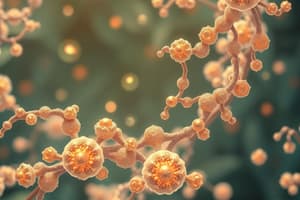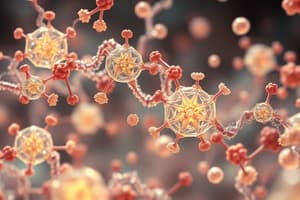Podcast
Questions and Answers
What is the primary function of carbohydrates in living organisms?
What is the primary function of carbohydrates in living organisms?
- Hormone production
- Energy storage (correct)
- Structural support (correct)
- Information storage
Which biomolecule is primarily involved in energy transfer within cells?
Which biomolecule is primarily involved in energy transfer within cells?
- ATP (correct)
- Proteins
- Lipids
- Nucleic acids
What process is primarily responsible for the synthesis of proteins?
What process is primarily responsible for the synthesis of proteins?
- Transcription
- Replication
- Metabolism
- Translation (correct)
What role do enzymes play in biochemical reactions?
What role do enzymes play in biochemical reactions?
Which process breaks down molecules to produce energy?
Which process breaks down molecules to produce energy?
What is the composition of the cell membrane?
What is the composition of the cell membrane?
Which technique is used for separating biomolecules based on size and charge?
Which technique is used for separating biomolecules based on size and charge?
During cellular communication, what molecules are often involved?
During cellular communication, what molecules are often involved?
Flashcards are hidden until you start studying
Study Notes
Key Concepts in Biochemistry
-
Biomolecules
- Carbohydrates:
- Composed of carbon, hydrogen, and oxygen.
- Function as energy sources (e.g., glucose) and structural components (e.g., cellulose).
- Proteins:
- Made of amino acids linked by peptide bonds.
- Functions include catalysis (enzymes), transport, structure, and signaling.
- Lipids:
- Hydrophobic molecules including fats, oils, and steroids.
- Functions include energy storage, membrane structure, and signaling (e.g., hormones).
- Nucleic Acids:
- DNA and RNA composed of nucleotides.
- DNA stores genetic information; RNA is involved in protein synthesis.
- Carbohydrates:
-
Metabolism
- Catabolism:
- Breakdown of molecules to produce energy (e.g., glycolysis, Krebs cycle).
- Anabolism:
- Synthesis of complex molecules from simpler ones, requiring energy (e.g., protein synthesis).
- Catabolism:
-
Enzymes
- Biological catalysts that speed up chemical reactions.
- Lower activation energy required for reactions.
- Exhibit specificity for substrates and can be influenced by factors such as pH and temperature.
-
Energy Transfer
- ATP (Adenosine Triphosphate):
- Primary energy currency of the cell.
- Stores and transfers energy for cellular processes.
- ATP (Adenosine Triphosphate):
-
Cellular Structures
- Cell Membrane:
- Phospholipid bilayer with embedded proteins; regulates transport in and out of the cell.
- Organelles:
- Nucleus (stores DNA), mitochondria (energy production), ribosomes (protein synthesis).
- Cell Membrane:
-
Genetic Information
- DNA Replication:
- Process of duplicating DNA prior to cell division.
- Transcription:
- Synthesis of RNA from a DNA template.
- Translation:
- Synthesis of proteins from RNA sequence.
- DNA Replication:
-
Signal Transduction
- Mechanisms by which cells communicate and respond to external signals (e.g., hormones).
- Involves receptors, second messengers, and cellular responses.
-
Biochemical Techniques
- Chromatography:
- Separation of biomolecules based on size, charge, or affinity.
- Electrophoresis:
- Technique to separate nucleic acids or proteins based on size and charge.
- Spectroscopy:
- Technique for analyzing the composition of substances by measuring their interaction with electromagnetic radiation.
- Chromatography:
-
Clinical Biochemistry
- Application of biochemistry in medicine to diagnose and treat diseases (e.g., blood glucose monitoring, enzyme assays).
-
Biochemical Regulation
- Feedback inhibition:
- Mechanism where the end product of a metabolic pathway inhibits an earlier step.
- Allosteric regulation:
- Binding of regulatory molecules at sites other than the active site to modulate enzyme activity.
- Feedback inhibition:
Biomolecules
- Carbohydrates: Composed of carbon, hydrogen, and oxygen; serve as energy sources (e.g., glucose) and structural components (e.g., cellulose).
- Proteins: Made of amino acids linked by peptide bonds; function as enzymes, transport molecules, structural components, and signaling agents.
- Lipids: Hydrophobic molecules, including fats, oils, and steroids; essential for energy storage, cell membrane structure, and signaling (e.g., hormones).
- Nucleic Acids: DNA and RNA consist of nucleotides; DNA carries genetic information while RNA plays a crucial role in protein synthesis.
Metabolism
- Catabolism: Involves the breakdown of complex molecules to release energy through processes like glycolysis and the Krebs cycle.
- Anabolism: Refers to the synthesis of complex molecules from simpler ones, requiring energy input (e.g., protein synthesis).
Enzymes
- Biological catalysts that accelerate chemical reactions by lowering activation energy; exhibit specificity for substrates and are influenced by pH, temperature, and other factors.
Energy Transfer
- ATP (Adenosine Triphosphate): The primary energy currency of the cell; essential for storing and transferring energy for various cellular processes.
Cellular Structures
- Cell Membrane: A phospholipid bilayer with embedded proteins, crucial for regulating the transport of substances in and out of the cell.
- Organelles:
- Nucleus: Stores genetic material (DNA).
- Mitochondria: Responsible for energy production through ATP synthesis.
- Ribosomes: Sites for protein synthesis.
Genetic Information
- DNA Replication: The process of copying DNA before cell division.
- Transcription: The synthesis of RNA from a DNA template.
- Translation: The process of synthesizing proteins based on the RNA sequence.
Signal Transduction
- Mechanisms allowing cells to communicate and respond to external signals (e.g., hormones), involving receptors, second messengers, and cellular responses.
Biochemical Techniques
- Chromatography: A method for separating biomolecules based on size, charge, or binding affinity.
- Electrophoresis: Used to separate nucleic acids or proteins based on their size and charge.
- Spectroscopy: Analyzes the composition of substances through their interaction with electromagnetic radiation.
Clinical Biochemistry
- Application of biochemistry in medical contexts for diagnosing and treating diseases (e.g., blood glucose monitoring, enzyme assays).
Biochemical Regulation
- Feedback Inhibition: A process where the end product of a metabolic pathway inhibits an earlier step.
- Allosteric Regulation: The modification of enzyme activity through the binding of regulatory molecules at sites other than the active site.
Studying That Suits You
Use AI to generate personalized quizzes and flashcards to suit your learning preferences.




